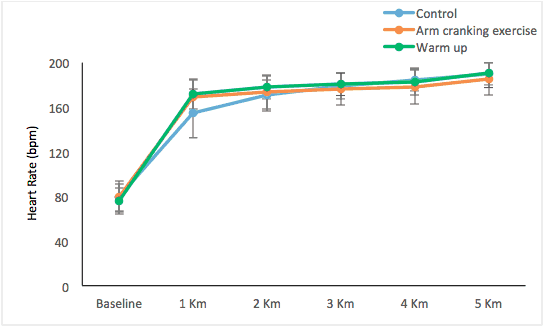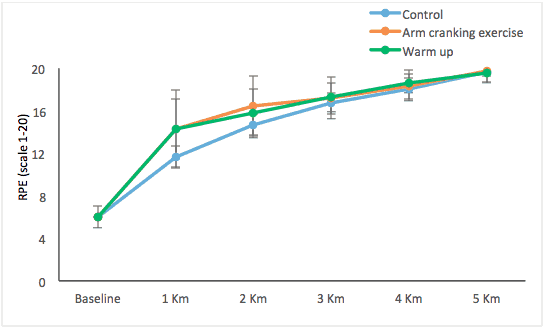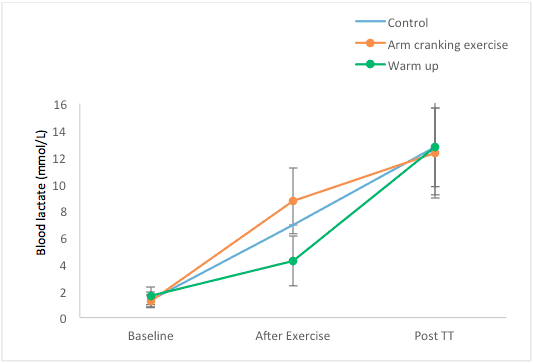The Effects of a Prior Warm Up Exercise and Prior Arm Cranking Exercise on Performance in a Subsequent 5 km Cycling Time Trial
Abstract
Performance in a 5 km cycling time-trial using an ergometric cycle was investigated in three groups of subjects, with heart rate and Rated Perceived Exertion (RPE) being monitored at baseline and during the time trial in all subjects. The three groups comprised a control group (n = 13) who performed no prior exercise prior to the time trial; a group who performed a self-paced warm up prior to the time trial (n = 12); and a group who performed severe arm cranking exercise prior to the time trial (n = 11). No differences between the three groups were found in performance in time trials, heart rate or RPE. Blood creatinine concentration was significantly raised in the arm cranking exercise group compared to the warm up group pre time trial, but there were no differences in this parameter at the end of the trial.
Introduction
The accumulation of metabolites has an effect on exercise tolerance, fatigue and other physiological responses. This effect on exercise can be investigated by prior exertion using a different set of muscle groups (Bangsbo, Madsen, Kiens and Richter, 1996; Nordsborg et al., 2003; Johnson, Mills, Brown and Sharpe, 2014). For example, the effect of prior exercise using high intensity arm cranking on maximum cycling power has been examined (Johnson et al., 2014).
The aims of this project were to investigate the effects on performance in a 5 km cycling time-trial of a prior warm up, which used the same muscle groups i.e. legs, with prior upper body exercise (arm cranking) which used a different set of muscle groups. The results of these two groups are compared to a control group in which no prior exercise was performed.
Materials and Methods
Thirteen subjects with a mean age of 20.1 years ± standard deviation (SD) of 0.9, mean height of 180.3 cm ± 9.5 and a mean weight of 76.0 kg ± 8.0 were entered into the study. Informed consent was received from each participant.
Participants refrained from exercise and drinking alcohol on the day preceding the time trials, and also refrained from consuming any food or caffeinated drinks in the 2 hours preceding arrival at the laboratory. Participants consumed one pint of water one hour before arrival at the laboratory. Subjects were divided into three exercise groups.
In the control group subjects performed a 5 km cycling time trial, using a Watt Bike, without any prior exercise. Nude body mass was taken pre and post exercise to estimate the loss of fluid by sweating. A blood sample was also taken pre and post exercise for the determination of lactate concentration. Measurements of heart rate and Rated Perceived Exertion (RPE) were taken at baseline and at each km of the cycling time trial.
In the second group subjects performed a self-paced 10 minute warm-up on ergometric cycles prior to the time trial. The heart rate was maintained between 70% and 80% of the predicted maximal heart rate. This was calculated as 220 minus the age of the subject. After the warm up there was a 2 minute rest period before the time trial began. Measurements of lactate concentration were taken at baseline, following the warm up and at the end of the trial. Measurements of heart rate and RPE were taken at the same intervals as the control group.
In the third group an arm cranking exercise preceded the time trial. This comprised 8 x 1 min arm cranking bouts at an intensity of 1.5-2 W per kg of body mass. Each bout of exercise was separated by a 30 second rest interval, with a 4 minute rest period separating the last bout of exercise and the beginning of the cycling time trial. Measurements were taken at the same times as the warm up group.
Analysis of variance (ANOVA) was performed using an online tool (Kirkman, 1996), and t tests were also performed online (Student’s T-Test, 2011).
Results
In the control group (n = 11) nude body mass was 76.0 kg ± 8.0 prior to exercise and 75.9 ± 8.1 post exercise. A matched t test showed that this difference was not statistically significant (p = 0.32). There was no statistically significant difference in time-trial times between control, prior warm up and prior arm cranking exercise groups; values were 491.00 ± 34.22; 483.54 ± 27.23; 504.50 ± 45.00 seconds respectively. A one way ANOVA gave a p value of 0.35 (F statistic = 1.083; 2 degrees of freedom (df)).
Following exercise on an ergometric cycle heart rate in the control, prior warm up and prior arm cranking exercise groups increased (Figure 1). The results obtained were similar for each group with the mean heart rate of each group increasing markedly from baseline to measurement at 1 km and being maintained throughout the time trial. One way ANOVAs showed that these changes were statistically very highly significant in each group. ANOVA results of change in heart rate over the time courses of the groups gave p values of < 0.0001 for each (control, F = 110.0; prior warm up, F = 163.1; prior arm cranking exercise, F = 84.3; 5 df).

Figure 1. Heart rate in Control (n = 13), Prior Warm Up (n = 12), and Prior Arm Cranking Exercise (n = 11) groups following exercise using an ergometric cycle. Error bars show standard deviation (SD).
The RPE values also showed very high statistically significant increases in these three groups following ergometric cycle exercise (Figure 2). ANOVA results were p<0.0001 for the time courses for each group (control, F = 203.0; prior warm up, F = 104.0; prior arm cranking exercise, F = 58.2; df = 5).

Figure 2. RPE in Control (n = 13), Prior Warm Up (n = 12), and Prior Arm Cranking Exercise (n = 11) groups following exercise using an ergometric cycle. Error bars show SD.
Blood lactate concentrations increased significantly with exercise (Figure 3). In the control group lactate was significantly increased following the time trial (p < 0.0001, matched group two tailed t test). In the prior warm up group lactate concentrations increased from baseline following warm up and then increased again following the time trial. Data from one subject in this group was removed prior to analysis due an incomplete data set. These changes were statistically significant by ANOVA (p < 0.0001, F = 72.6, 2 df). Similarly, the increases in lactate in the prior arm cranking exercise group were statistically significant (p < 0.0001, F = 65.3, 2 df). Comparison of blood lactate concentrations, using an unpaired t test, showed that the difference between the prior warm up and prior arm cranking exercise groups after exercise (but pre time trial) was statistically significant (p < 0.0001). ANOVAs which compared lactate concentrations in the three groups at baseline, or after the cycling time trial showed that were no significant differences between these groups (p = 0.21 and 0.93 respectively).

Figure 3. Blood lactate in Control (n = 13), Prior Warm Up (n = 12), and Prior Arm Cranking Exercise (n = 12) groups after exercise (Pre Time Trial) and post time trial (TT) on an ergometric cycle. Error bars show SD.
Discussion
The results show that both heart rate and RPE increased in the control, prior warm up and prior arm cranking exercise groups in response to time trial cycling on an ergometric cycle. No appreciable differences in these two parameters were observed between the participants in each group with the heart rate and RPE time courses (Figures 1 and 2) of the prior warm up and prior arm cranking exercise groups being nearly superimposable. Similarly, there was no significant difference between control, prior warm up and prior arm cranking exercise groups in performance in subsequent time trials, as indicated by comparison of times in the time trials. These results contrast with those described by Johnson et al. (2014) who found that maximum cycling power and exercise duration was reduced in subjects who had undergone prior severe intensity arm-cranking exercise when compared to those who had no prior exercise.
There was also no significant difference between the three groups in blood lactate concentrations measured at baseline and post time trial cycling. Blood lactate concentration was significantly higher pre time trial in the arm cranking exercise group compared to the warm up group. These results are therefore in agreement with those found by Johnson et al. (2014) in their study which compared a prior severe intensity arm-cranking exercise compared with no prior exercise. These differences are likely to reflect the increased work of participants undertaking arm cranking exercise compared to a self-paced warm up.
References
Bangsbo J., Madsen K., Kiens B. and Richter E.A. (1996). Effect of muscle acidity on muscle metabolism and fatigue during intense exercise in man. Journal of Physiology. 495(Pt 2), 587-596.
Johnson M.A., Mills D.E., Brown P.I. and Sharpe G.R. (2014). Prior upper body exercise reduces cycling work capacity but not critical power. Medicine and Science in Sports and Exercise. 46, 802-808.
Kirkman, T.W. (1996). ANOVA: ANalysis Of VAriance between groups. In: Statistics to Use. Retrieved from: http://www.physics.csbsju.edu/stats/ on 16th March 2015.
Miura A., Shiragiku C., Hirotoshi Y., Kitano A., Endo M.Y., Barstow T.J., Morton R.H. and Fukuba Y. (2009). The effect of prior heavy exercise on the parameters of the power-duration curve for cycle ergometry. Applied Physiology, Nutrition, and Metabolism. 34, 1001-1007.
Nordsborg N., Mohr M., Pedersen L.D., Nielsen J.J., Langberg H. & Bangsbo J. (2003). Muscle interstitial potassium kinetics during intense exhaustive exercise: effect of previous arm exercise. American Journal of Physiology – Regulatory, Integrative and Comparative Physiology. 285(1), R143-R148.
Student’s T-Test (2011). Retrieved from: http://studentsttest.com/ on 16th March 2015.